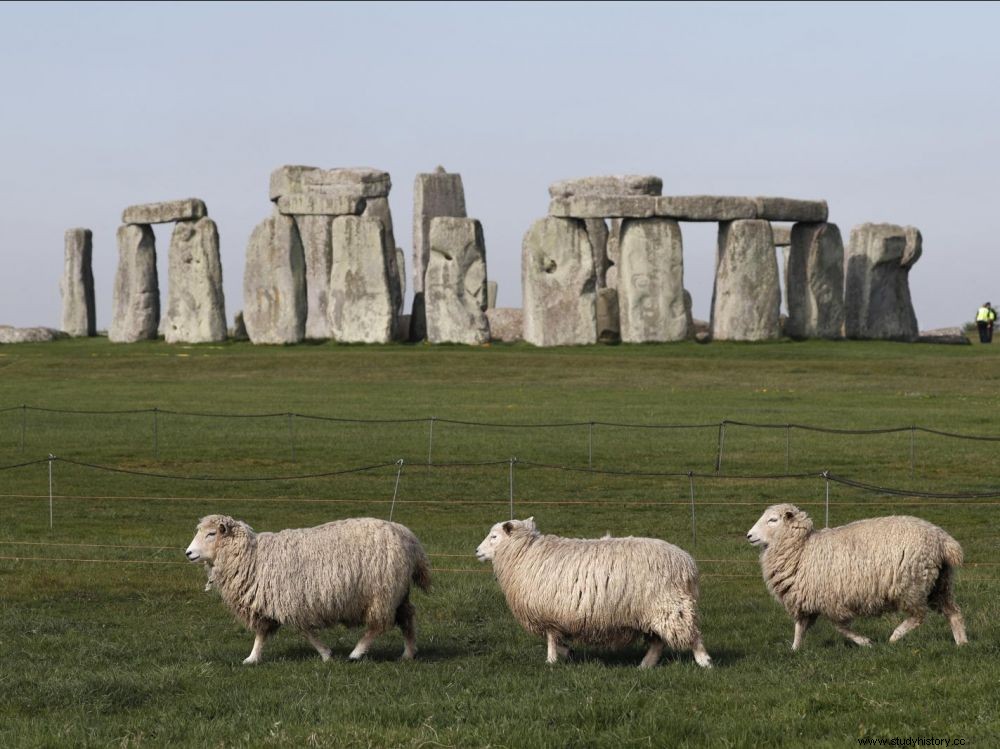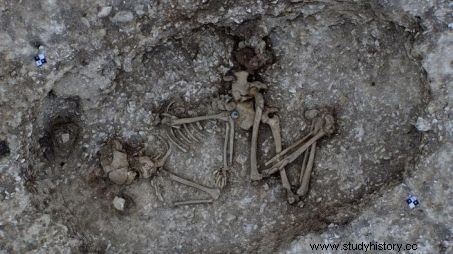The first excavations carried out on the route of the future Stonehenge tunnel have brought to light traces of human activity, some dating back more than 7,000 years:tombs from the Bronze Age have notably been discovered by archaeologists. These announcements fuel the controversy around the project to build a tunnel near this UNESCO World Heritage Site.

The site of Stonehenge (England) is at the heart of a controversy following a tunnel project near the megalithic complex.
Stonehenge has not finished revealing its secrets:after the discovery, in the summer of 2020, of the origin of the site's megaliths (which we echoed in a previous article in Sciences et Avenir ), archaeological research has brought to light numerous artefacts dating back several millennia. These investigations are the first step in a series of preliminary excavations for the construction of a tunnel near Stonehenge:a controversial project, which aims in particular to replace the road axis currently running along the megalithic site. Wessex Archeology, which oversees this work, details in a press release published on February 5, 2021 the first results of these excavations, during which more than 1,700 earthen wells were excavated and sieved by hand.
Several traces of human activity
Archaeologists have thus unearthed several burials dated to the Bell Beaker (about 4,500 years ago), in which there were a large number of artefacts:among them, fragments of pottery, carved flints, animal bones, and even an object totally unknown to specialists. Found in the tomb of a young woman, this small cylindrical piece of schist has intrigued experts. “It is very difficult to define what it could have been, and if it was indeed a functional object , says Dr. Matt Leivers, consultant archaeologist at Wessex Archeology. We hope to be able to determine if it was a container for an organic substance, but it could also be part of a larger object, or a piece made specifically for inclusion in the burial ”. In addition to these artifacts, a C-shaped enclosure, dated to the Late Bronze Age, has also been unearthed:archaeologists speculate that this was a working space, partly because of the large quantity of calcined flint found in the ground.
Matt Leivers explains that these discoveries are perfectly in line with what was expected by specialists - with the exception of the small piece of shale:"This research is the result of a very long process of work which sought to find a route for the A303 (the planned tunnel) avoiding as much archaeological work as possible; we were therefore not surprised by the results of the excavations, neither in terms of what was there nor in terms of what was not there ”.
No startling discovery, but details that help to better understand life around Stonehenge
Although anticipated, these discoveries represent a major step forward in understanding more precisely the life around the site as it was several millennia ago:“Most of the discoveries allow us to detail the portrait that we have of the lives of people around Stonehenge during the construction and use of the site ”, emphasizes Dr. Leivers.
Most of the relics have been dated to the late Neolithic or early Bronze Age:this period corresponds to the time of the construction of the Sarsen circles and the trilithons.
Stonehenge has not finished revealing its secrets:after the discovery, in the summer of 2020, of the origin of the site's megaliths (which we echoed in a previous article in Sciences et Avenir ), archaeological research has brought to light numerous artefacts dating back several millennia. These investigations are the first step in a series of preliminary excavations for the construction of a tunnel near Stonehenge:a controversial project, which aims in particular to replace the road axis currently running along the megalithic site. Wessex Archeology, which oversees this work, details in a press release published on February 5, 2021 the first results of these excavations, during which more than 1,700 earthen wells were excavated and sieved by hand.
Several traces of human activity
Archaeologists have thus unearthed several burials dated to the Bell Beaker (about 4,500 years ago), in which there were a large number of artefacts:among them, fragments of pottery, carved flints, animal bones, and even an object totally unknown to specialists. Found in the tomb of a young woman, this small cylindrical piece of schist has intrigued experts. “It is very difficult to define what it could have been, and if it was indeed a functional object , says Dr. Matt Leivers, consultant archaeologist at Wessex Archeology. We hope to be able to determine if it was a container for an organic substance, but it could also be part of a larger object, or a piece made specifically for inclusion in the burial ”. In addition to these artifacts, a C-shaped enclosure, dated to the Late Bronze Age, has also been unearthed:archaeologists speculate that this was a working space, partly because of the large quantity of calcined flint found in the ground.
Matt Leivers explains that these discoveries are perfectly in line with what was expected by specialists - with the exception of the small piece of shale:"This research is the result of a very long process of work which sought to find a route for the A303 (the planned tunnel) avoiding as much archaeological work as possible; we were therefore not surprised by the results of the excavations, neither in terms of what was there nor in terms of what was not there ”.
No startling discovery, but details that help to better understand life around Stonehenge
Although anticipated, these discoveries represent a major step forward in understanding more precisely the life around the site as it was several millennia ago:“Most of the discoveries allow us to detail the portrait that we have of the lives of people around Stonehenge during the construction and use of the site ”, emphasizes Dr. Leivers.
Most of the relics have been dated to the late Neolithic or early Bronze Age:this period corresponds to the time of the construction of the Sarsen circles and the trilithons. “These objects, explains Dr. Leivers, allow us to say that the area around Stonehenge was not empty, but that people lived there, made tools, used pots, died and, given the arrangement of the stones, buried their dead ”.
Indeed, the excavated burials offer important clues to burial practices of the time:“Dated Bell Beaker tombs and Early Bronze Age crematorium urns suggest that burial was widespread than the construction of burial mounds ”, says Dr. Leivers.
The finds will soon be delivered to the Salisbury Museum for display.

One of the burials discovered near the site of the future Stonehenge tunnel. Credits:Wessex Archeology
Discoveries made as part of a controversial project
These important findings are nevertheless part of a controversial project. The second part of the archaeological excavations, which should begin later this year, will last 18 months; the approximately 150 archaeologists expected will try to inventory as many artefacts as possible before the planned start date of the work, in 2023. Faced with the imminence of the construction site, some experts fear that the remains cannot be inventoried and will be definitively destroyed during the works. This is for example the case of Prof. Mike Parker Pearson, at the head of several excavations carried out at Stonehenge in recent years. “We are talking about a loss of around half a million artifacts , he explained a few months ago to the Guardian . They will be destroyed before they can be inventoried. You might say "these are just a pile of old flint", but they tell us about the use of the Stonehenge site through the ages ”.
Contacted by Sciences et Avenir, Prof. Pearson confirms his position:"It's a tragedy , he tells us. The tunnel is too short and the damage to the WHS (World Heritage Site, a UNESCO World Heritage Site, editor's note) will be irremediable. The project was condemned by Unesco and rejected by the engineers in charge of planning, but the Minister of Transport ignored their conclusions". According to Prof. Pearson, those responsible for this destruction are not the archaeologists, but the government authorities in charge of the project. "I am confident that Wessex Archeology will do an excellent job with the limited resources they have at Highways England (national transport infrastructure company, editor's note). Unfortunately, the specifications given to them by Highways England are completely unsuited to the high standards of work required for such a site. The blame for this lies not with archaeologists but with government transport and heritage agencies who set the standards by which Wessex archeology is forced to work" .
Asked about this, Dr. Leivers is reassuring:“We have worked in the Stonehenge area for decades and know very well the challenges of its archeology. Wessex Archeology is one of the largest and most experienced archeology organizations in the UK; we have extensive experience working on large infrastructure projects. Additionally, due to the sensitivity of this program, we work in collaboration with various other archaeologists in the UK, and with Inrap ( National Institute for Preventive Research, editor's note), in order to provide technical and academic expertise and sufficient means ”. And to conclude:“Although destruction is an inevitable part of the archaeological process, the creation of knowledge more than compensates for it ”.
